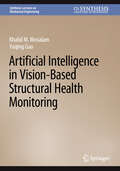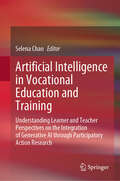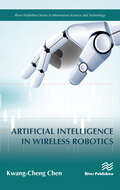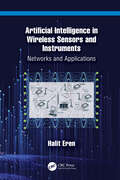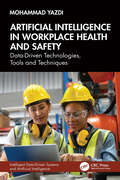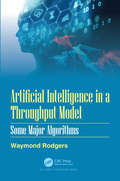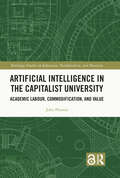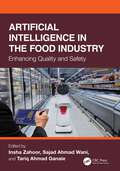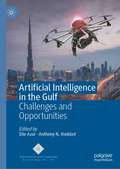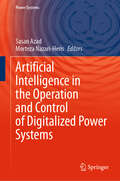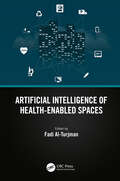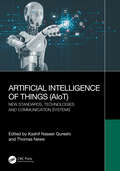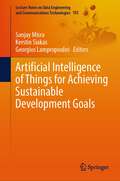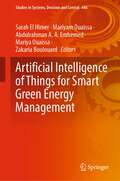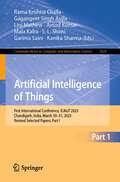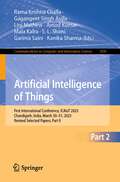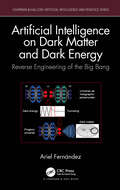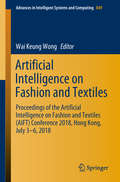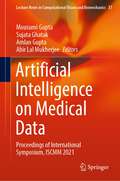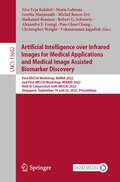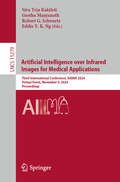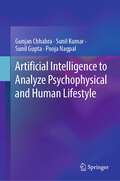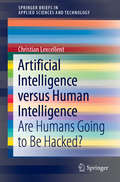- Table View
- List View
Artificial Intelligence in Vision-Based Structural Health Monitoring (Synthesis Lectures on Mechanical Engineering)
by Khalid M. Mosalam Yuqing GaoThis book provides a comprehensive coverage of the state-of-the-art artificial intelligence (AI) technologies in vision-based structural health monitoring (SHM). In this data explosion epoch, AI-aided SHM and rapid damage assessment after natural hazards have become of great interest in civil and structural engineering, where using machine and deep learning in vision-based SHM brings new research direction. As researchers begin to apply these concepts to the structural engineering domain, especially in SHM, several critical scientific questions need to be addressed: (1) What can AI solve for the SHM problems? (2) What are the relevant AI technologies? (3) What is the effectiveness of the AI approaches in vision-based SHM? (4) How to improve the adaptability of the AI approaches for practical projects? (5) How to build a resilient AI-aided disaster prevention system making use of the vision-based SHM? This book introduces and implements the state-of-the-art machine learning and deep learning technologies for vision-based SHM applications. Specifically, corresponding to the above-mentioned scientific questions, it consists of: (1) motivation, background & progress of AI-aided vision-based SHM, (2) fundamentals of machine learning & deep learning approaches, (3) basic AI applications in vision-based SHM, (4) advanced topics & approaches, and (5) resilient AI-aided applications. In the introduction, a brief coverage about the development progress of AI technologies in the vision-based area is presented. It gives the readers the motivations and background of the relevant research. In Part I, basic knowledges of machine and deep learning are introduced, which provide the foundation for the readers irrespective of their background. In Part II, to verify the effectiveness of the AI methods, the key procedure of the typical AI-aided SHM applications (classification, localization, and segmentation) is explored, including vision data collection, data pre-processing,transfer learning-based training mechanism, evaluation, and analysis. In Part III, advanced AI topics, e.g., generative adversarial network, semi-supervised learning, and active learning, are discussed. They aim to address several critical issues in practical projects, e.g., the lack of well-labeled data and imbalanced labels, to improve the adaptability of the AI models. In Part IV, the new concept of “resilient AI” is introduced to establish an intelligent disaster prevention system, multi-modality learning, multi-task learning, and interpretable AI technologies. These advances are aimed towards increasing the robustness and explainability of the AI-enabled SHM system, and ultimately leading to improved resiliency.The scope covered in this book is not only beneficial for education purposes but also is essential for modern industrial applications. The target audience is broad and includes students, engineers, and researchers in civil engineering, statistics, and computer science. Unique Book Features:• Provide a comprehensive review of the rapidly expanding field of vision-based structural health monitoring (SHM) using artificial intelligence approaches. • Re-organize fundamental knowledge specific to the machine and deep learning in vision tasks.• Include comprehensive details about the procedure of conducting AI approaches for vision-based SHM along with examples and exercises.• Cover a vast array of special topics and advanced AI-enabled vision-based SHM applications.• List a few potential extensions for inspiring the readers for future investigation.
Artificial Intelligence in Vocational Education and Training: Understanding Learner and Teacher Perspectives on the Integration of Generative AI through Participatory Action Research
by Selena ChanThis book details a series of studies across several levels of learning and vocational education and training (VET) discipline areas. In the main, the advent of natural language AI chatbots exampled by ChatGPT, has caused the educational sector to take on a defensive stance. Both schools and the higher education sector are engaged in an on-going &‘arms race&’ to prevent learners from using AI to augment assessments. Therefore, there has been a focus on plagiarism prevention, rather than to better understand the potentialities for utilizing AI to support better learning. This book explores the collaborative development and planning between educational developers/learning designers and teachers to design learning activities which could leverage off various artificial intelligence (AI) platforms. In doing, support is provided for effective learning <span style="mso-ascii-font-family: Calibri; mso-hansi-font-family: Calibri; mso-bidi-font-family
Artificial Intelligence in Wireless Robotics (River Publishers Series In Information Science And Technology Ser.)
by Kwang-Cheng ChenRobots, autonomous vehicles, unmanned aerial vehicles, and smart factory, will significantly change human living style in digital society. Artificial Intelligence in Wireless Robotics introduces how wireless communications and networking technology enhances facilitation of artificial intelligence in robotics, which bridges basic multi-disciplinary knowledge among artificial intelligence, wireless communications, computing, and control in robotics. A unique aspect of the book is to introduce applying communication and signal processing techniques to enhance traditional artificial intelligence in robotics and multi-agent systems.The technical contents of this book include fundamental knowledge in robotics, cyber-physical systems, artificial intelligence, statistical decision and Markov decision process, reinforcement learning, state estimation, localization, computer vision and multi-modal data fusion, robot planning, multi-agent systems, networked multi-agent systems, security and robustness of networked robots, and ultra-reliable and low-latency machine-to-machine networking. Examples and exercises are provided for easy and effective comprehension.Engineers wishing to extend knowledge in the robotics, AI, and wireless communications, would be benefited from this book. In the meantime, the book is ready as a textbook for senior undergraduate students or first-year graduate students in electrical engineering, computer engineering, computer science, and general engineering students. The readers of this book shall have basic knowledge in undergraduate probability and linear algebra, and basic programming capability, in order to enjoy deep reading.
Artificial Intelligence in Wireless Sensors and Instruments: Networks and Applications
by Halit ErenThis book heralds a new era in instrumentation and measurements. It combines artificial intelligence (AI) and wireless communications technologies with instrumentation and measurement systems to function as a single unit. AI has advanced considerably due to deep learning utilizing artificial neural networks, availability of large and curated datasets, implementation of a new generation of fast processors having millions of transistors in chips, advanced algorithms, competitive commercial interests, and interests of governments to gain advantages. At the same time, new and highly advanced wireless technologies open new frontiers in communication systems, both technologically and in terms of applications aspects. Advanced technologies such as 5G and 6G networks enable easy use of communication systems by billions of people as well as by billions of machine-to-machine systems.In this book, the communication principles are explained and the implementation of AI on wireless networks is discussed. Many examples are provided. The author discusses instruments and instrumentation networks, modern sensors, and transducers in detail.AI is the technology humans have created where the machines do not only assist us but also think for us creatively in some cases, excelling humans thinking and reasoning. This book includes a chapter explaining how this is done, backed up with more than 50 figures. The security issues, fairness, efficiency, and social impact and acceptance of AI are highlighted. As explained in this book, AI and wireless communications are changing our lives in many ways, including entertainment, games, social interactions, medicine and healthcare, R&D, automated living, intelligent transport systems, finance and economy, and the Internet of Things.
Artificial Intelligence in Workplace Health and Safety: Data-Driven Technologies, Tools and Techniques (Intelligent Data-Driven Systems and Artificial Intelligence)
by Mohammad YazdiIn today's dynamic workplace environment, ensuring the safety and well-being of employees has never been more critical. This book explores cutting-edge technologies intersecting with workplace safety to deliver effective and practical results.Artificial Intelligence in Workplace Health and Safety: Data-Driven Technologies, Tools and Techniques offers a comprehensive roadmap for professionals, researchers, and practitioners in work health and safety (WHS), revolutionizing traditional approaches through the integration of data-driven methodologies and artificial intelligence. Covering the foundations and practical applications of data-driven WHS and historical perspectives to current regulatory frameworks, it investigates the key concepts of data collection, management, and integration. Through real-world case studies and examples, readers can discover how AI technologies such as machine learning, computer vision, and natural language processing are reshaping WHS practices, mitigating risks, and optimizing safety measures. The reader will learn applications of AI and data-driven methodologies in their workplace settings to improve safety. With its practical insights, real-world examples, and progressive approach, this title ensures that readers are not just prepared for the future of WHS but empowered to shape it for better. This text is written for professionals and practitioners seeking to enhance workplace safety through innovative technologies. This extends to safety professionals, HR personnel and engineers across different sectors.
Artificial Intelligence in a Throughput Model: Some Major Algorithms
by Waymond RodgersPhysical and behavioral biometric technologies such as fingerprinting, facial recognition, voice identification, etc. have enhanced the level of security substantially in recent years. Governments and corporates have employed these technologies to achieve better customer satisfaction. However, biometrics faces major challenges in reducing criminal, terrorist activities and electronic frauds, especially in choosing appropriate decision-making algorithms. To face this challenge, new developments have been made, that amalgamate biometrics with artificial intelligence (AI) in decision-making modeling. Advanced software algorithms of AI, processing information offered by biometric technology, achieve better results. This has led to growth in the biometrics technology industry, and is set to increase the security and internal control operations manifold. This book provides an overview of the existing biometric technologies, decision-making algorithms and the growth opportunity in biometrics. The book proposes a throughput model, which draws on computer science, economics and psychology to model perceptual, informational sources, judgmental processes and decision choice algorithms. It reviews how biometrics might be applied to reduce risks to individuals and organizations, especially when dealing with digital-based media.
Artificial Intelligence in the Capitalist University: Academic Labour, Commodification, and Value (Routledge Studies in Education, Neoliberalism, and Marxism)
by John PrestonUsing Marxist critique, this book explores manifestations of Artificial Intelligence (AI) in Higher Education and demonstrates how it contributes to the functioning and existence of the capitalist university. Challenging the idea that AI is a break from previous capitalist technologies, the book offers nuanced examination of the impacts of AI on the control and regulation of academic work and labour, on digital learning and remote teaching, and on the value of learning and knowledge. Applying a Marxist perspective, Preston argues that commodity fetishism, surveillance, and increasing productivity ushered in by the growth of AI, further alienates and exploits academic labour and commodifies learning and research. The text puts forward a solid theoretical framework and methodology for thinking about AI to inform critical and revolutionary pedagogies. Offering an impactful and timely analysis, this book provides a critical engagement and application of key Marxist concepts in the study of AI’s role in Higher Education. It will be of interest to those working or researching in Higher Education.
Artificial Intelligence in the Food Industry: Enhancing Quality and Safety
by Tariq Ahmad Ganaie Sajad Ahmad Wani Insha ZahoorIn this changing world of food processing and handling, efficiency and safety are paramount. Artificial Intelligence in the Food Industry: Enhancing Quality and Safety offers a groundbreaking exploration of how artificial intelligence (AI) technologies can address these critical needs. This book explores the transformative potential of AI, machine learning (ML), and deep learning (DL) algorithms in revolutionizing the food industry. By overcoming the limitations of human involvement, AI ensures a more reliable demand-supply chain and enhances food safety.As the global population grows and food consumption reaches unprecedented levels, the demand for innovative solutions is urgent. This book demonstrates how intelligent systems can accurately assess food quality, implement control mechanisms, categorize foods, and conduct predictive analyses. Such advancements are reshaping sectors, including dairy, bakery, beverages, and fruits and vegetables, making this an indispensable guide for food production and safety professionals.It explores several cutting-edge topics such as the role of ML and computer vision in the agri-food industry, the potential of 3D printing, and the integration of AI with sensory technologies like electronic noses, electronic tongues, and near-infrared spectroscopy. These insights highlight how AI can significantly enhance food quality and productivity, benefiting both consumers and industry players.Artificial Intelligence in the Food Industry not only showcases current advancements but also emphasizes the need for ongoing research and innovation. By inviting readers to explore AI’s transformative potential in food production and service, this book ensures a safer, more efficient, and sustainable future for the food industry.A vital resource for researchers, scientists, and professionals in the food industry, this book presents comprehensive information on ML techniques to improve food quality, AI applications in pesticide management, food inspection, grading using image processing, and the use of robots for food safety and warehouse management.
Artificial Intelligence in the Gulf
by Elie Azar Anthony N. HaddadThis book presents the first broad reflection on the challenges, opportunities, and implications of Artificial Intelligence (AI) in the Gulf Cooperation Council (GCC). Unique results and insights are derived through case studies from diverse disciplines, including engineering, economics, data science, policy-making, governance, and humanscience. Particularly related to these ‘softer’ disciplines, we make some unexplored yet topical contributions to the literature, with a focus on the GCC (but by no means limited to it), including AI and implications for women, Islamic schools of thought on AI, and the power of AI to help deliver wellbeing and happiness in cities and urban spaces. Finally, the readers are provided with a synthesis of ideas, lessons learned, and a path forward based on the diverse content of the chapters. The book caters to the educated non specialist with interest in AI, targeting a wide audience including professionals, academics, government officials, policymakers, entrepreneurs, and non-governmental organizations.
Artificial Intelligence in the Operation and Control of Digitalized Power Systems (Power Systems)
by Morteza Nazari-Heris Sasan AzadThis book covers the practical application of AI-based methods in modern power systems. The complexity of current power system operations has dramatically increased due to the higher penetration of renewable energy sources and power electronic components. Therefore, providing efficient techniques is essential for secure and clean power system operation. This book focuses on the data-driven operation of the digitalized power system using machine language (ML). First, the basics of power system operation and control are presented, covering various areas of system control and operation. Next, significant advances in modern power systems and their corresponding challenges are discussed, and artificial intelligence (AI)-powered techniques, specifically machine learning, are introduced to address these issues. The book also explores AI-powered applications in the operation of power systems. These applications include various aspects of the data-driven process in both situational awareness and control areas. They are presented as practical examples indicating the implementation of an ML-based method to solve operational problems. Artificial Intelligence in the Operation and Control of Digitalized Power Systems is a valuable guide for students, researchers, and practicing engineers to AI-based techniques and real-world applications in power systems.
Artificial Intelligence of Health-Enabled Spaces
by Fadi Al-TurjmanArtificial Intelligence of Health-Enabled Spaces (AIoH) has made a number of revolutionary advances in clinical studies that we are aware of. Among these advances, intelligent and medical services are gaining a great deal of interest. Nowadays, AI-powered technologies are not only used in saving lives, but also in our daily life activities in diagnosing, controlling, and even tracking of COVID-19 patients. These AI-powered solutions are expected to communicate with cellular networks smoothly in the next-generation networks (5G/6G and beyond) for more effective/critical medical applications. This will open the door for other interesting research areas. This book focuses on the development and analysis of artificial intelligence (AI) model applications across multiple disciplines. AI-based deep learning models, fuzzy and hybrid intelligent systems, and intrinsic explainable models are also presented in this book. Some of the fields considered in this smart health-oriented book include AI applications in electrical engineering, biomedical engineering, environmental engineering, computer engineering, education, cyber security, chemistry, pharmacy, molecular biology, and tourism. This book is dedicated to addressing the major challenges in fighting diseases and psychological issues using AI. These challenges vary from cost and complexity to availability and accuracy. The aim of this book is hence to focus on both the design and implementation aspects of AI-based approaches in the proposed health-related solutions. Targeted readers are from varying disciplines who are interested in implementing the smart planet/environments vision via intelligent enabling technologies.
Artificial Intelligence of Things (AIoT): New Standards, Technologies and Communication Systems
by Kashif Naseer Qureshi Thomas NeweThis book is devoted to the new standards, technologies, and communication systems for Artificial Intelligence of Things (AIoT) networks. Smart and intelligent communication networks have gained significant attention due to the combination of AI and IoT networks to improve human and machine interfaces and enhance data processing and services. AIoT networks involve the collection of data from several devices and sensor nodes in the environment. AI can enhance these networks to make them faster, greener, smarter, and safer. Computer vision, language processing, and speech recognition are some examples of AIoT networks.Due to a large number of devices in today’s world, efficient and intelligent data processing is essential for problem-solving and decision-making. AI multiplies the value of these networks and promotes intelligence and learning capabilities, especially in homes, offices, and cities. However, several challenges have been observed in deploying AIoT networks, such as scalability, complexity, accuracy, and robustness. In addition, these networks are integrated with cloud, 5G networks, and blockchain methods for service provision. Many different solutions have been proposed to address issues related to machine and deep learning methods, ontology-based approaches, genetic algorithms, and fuzzy-based systems.This book aims to contribute to the state of the art and present current standards, technologies, and approaches for AIoT networks. This book focuses on existing solutions in AIoT network technologies, applications, services, standards, architectures, and security provisions. This book also introduces some new architectures and models for AIoT networks.
Artificial Intelligence of Things for Achieving Sustainable Development Goals (Lecture Notes on Data Engineering and Communications Technologies #192)
by Sanjay Misra Kerstin Siakas Georgios LampropoulosThis book covers various topics and trends regarding Artificial Intelligence (AI), Internet of Things (IoT), and their applications in society, industry, and environment for achieving Sustainable Development Goals (SDGs) suggested by the United Nations. Additionally, it discusses their advancements and fusion as well as the realization of Artificial Intelligence of Things (AIoT). The book aims to provide an overview and recent research into the fusion, integration, advancements, and impact of these technologies in the context of SDGs achievement. The topics include the applications of AI, IoT, big data, AI-based and IoT-based cloud computing, machine learning and deep learning techniques, and blockchain among others for achieving SDGs. It also presents findings and discussions on potential application domains, addresses open issues and challenges, offers solutions, and provides suggestions for future research for achieving SDGs. The chapters are clustered, according to particular SDGsor areas of focus, into: i) the realization of AIoT for SDGs, ii) the role of AIoT in achieving society and wellbeing-related SDGs, iii) the fulfillment of industrial sectors, infrastructure, and economy-related SDGs through AIoT, and iv) the use of AIoT to aid natural resources and environment-related SDGs. The book assists researchers, practitioners, professionals, and academicians of various scientific fields in exploring and better understanding these state-of-the-art technologies, their advancements, impact, future potentials and benefits, and their role in successfully achieving SDGs.The book:· Offers an in-depth overview of AIoT for achieving SDGs.· Presents the fusion of AI and IoT for bringing a significant change in everyday life and fulfilling SDGs.· Highlights innovative solutions and results of AIoT integration in several domains for achieving SDGs.· Showcases the influence of AIoT on promoting and improving sustainability in the context of SDGs.· Discusses the issues, benefits, solutions, and impact of AIoT in society, industry, and environment for achieving SDGs.
Artificial Intelligence of Things for Smart Green Energy Management (Studies in Systems, Decision and Control #446)
by Mariya Ouaissa Zakaria Boulouard Mariyam Ouaissa Sarah El Himer Abdulrahman A. A. EmhemedThis book is intended to assist in the development of smart and efficient green energy solutions. It introduces energy systems, power generation, and power demands which able to minimise generation costs, power loss or environmental effects. It proposes cutting-edge solutions and approaches based on recent technologies such as intelligent renewable energy systems (wind and solar). These solutions, applied to different sectors, can provide a solid basis for meeting the needs of both developed and developing countries. The book provides a collection of contributions including new techniques, methods, algorithms, practical solutions and models based on applying artificial intelligence and the Internet of things into green energy management systems. It provides a comprehensive reference for researchers, scholars and industry in the field of green energy and computational intelligence.
Artificial Intelligence of Things for Smarter Eco-Cities: Pioneering the Environmental Synergies of Urban Brain, Digital Twin, Metabolic Circularity, and Platform
by Simon Elias BibriThis book takes readers on a captivating journey into the transformative role of Artificial Intelligence (AI) and AI of Things (AIoT) technologies in reshaping sustainable urban development. By combining comprehensive theoretical analyses, synthesized empirical evidence, and practical case studies, it offers pioneering interdisciplinary insights and unifying frameworks. The book highlights the synergistic integration of Urban Brain (UB), Urban Digital Twin (UDT), Smart Urban Metabolism (SUM), and platform urbanism, underscored by their collaborative potential to revolutionize the environmental management, planning, and governance of smarter eco‑cities and sustainable smart cities. It leverages cutting‑edge technologies and data‑driven approaches to optimize urban systems, resource efficiency, and resilience. This approach provides a holistic understanding of the rapidly evolving landscape of AI‑ and AIoT‑driven sustainable urban development.Targeting a broad and diverse audience across multiple disciplines and fields, the book aims to share state‑of‑the‑art research, present innovative solutions, and forecast future trends in urban sustainability. As both a seminal reference and a valuable resource for researchers, practitioners, industry experts, and policymakers, it provides essential guidance for those engaged in driving technological innovation, steering urban transformation, promoting environmental sustainability, or working at the crossroads of these critical areas.
Artificial Intelligence of Things: First International Conference, ICAIoT 2023, Chandigarh, India, March 30–31, 2023, Revised Selected Papers, Part I (Communications in Computer and Information Science #1929)
by Kanika Sharma Mala Kalra Gagangeet Singh Aujla Rama Krishna Challa Lini Mathew Amod Kumar S. L. Shimi Garima SainiThese two volumes constitute the revised selected papers of First International Conference, ICAIoT 2023, held in Chandigarh, India, during March 30–31, 2023.The 47 full papers and the 10 short papers included in this volume were carefully reviewed and selected from 401 submissions. The two books focus on research issues, opportunities and challenges of AI and IoT applications. They present the most recent innovations, trends, and concerns as well as practical challenges encountered and solutions adopted in the fields of AI algorithms implementation in IoT Systems
Artificial Intelligence of Things: First International Conference, ICAIoT 2023, Chandigarh, India, March 30–31, 2023, Revised Selected Papers, Part II (Communications in Computer and Information Science #1930)
by Kanika Sharma Mala Kalra Gagangeet Singh Aujla Rama Krishna Challa Lini Mathew Amod Kumar S. L. Shimi Garima SainiThese two volumes constitute the revised selected papers of First International Conference, ICAIoT 2023, held in Chandigarh, India, during March 30–31, 2023.The 47 full papers and the 10 short papers included in this volume were carefully reviewed and selected from 401 submissions. The two books focus on research issues, opportunities and challenges of AI and IoT applications. They present the most recent innovations, trends, and concerns as well as practical challenges encountered and solutions adopted in the fields of AI algorithms implementation in IoT Systems
Artificial Intelligence on Dark Matter and Dark Energy: Reverse Engineering of the Big Bang (Chapman & Hall/CRC Artificial Intelligence and Robotics Series)
by Ariel FernándezAs we prod the cosmos at very large scales, basic tenets of physics seem to crumble under the weight of contradicting evidence. This book helps mitigate the crisis. It resorts to artificial intelligence (AI) for answers and describes the outcome of this quest in terms of an ur-universe, a quintessential compact multiply connected space that incorporates a fifth dimension to encode space-time as a latent manifold. In some ways, AI is bolder than humans because the huge corpus of knowledge, starting with the prodigious Standard Model (SM) of particle physics, poses almost no burden to its conjecture-framing processes. Why not feed AI with the SM enriched by the troubling cosmological phenomenology on dark matter and dark energy and see where AI takes us vis-à-vis reconciling the conflicting data with the laws of physics? This is precisely the intellectual adventure described in this book and – to the best of our knowledge – in no other book on the shelf. As the reader will discover, many AI conjectures and validations ultimately make a lot of sense, even if their boldness does not feel altogether "human" yet. This book is written for a broad readership. Prerequisites are minimal, but a background in college math/physics/computer science is desirable. This book does not merely describe what is known about dark matter and dark energy but also provides readers with intellectual tools to engage in a quest for the deepest cosmological mystery.
Artificial Intelligence on Fashion and Textiles: Proceedings Of The Artificial Intelligence On Fashion And Textile (aift) Conference 2018, Hong Kong, July 3-6 2018 (Advances In Intelligent Systems and Computing #849)
by Wai Keung WongThe book includes the Proceedings of the Artificial Intelligence on Fashion and Textiles conference 2018 which provides state-of-the-art techniques and applications of AI in the fashion and textile industries. It is essential reading for scientists, researchers and R&D professionals working in the field of AI with applications in the fashion and textile industry; managers in the fashion and textile enterprises; and anyone with an interest in the applications of AI. Over the last two decades, with the great advancement of computer technology, academic research in artificial intelligence (AI) and its applications in fashion and textile supply chain has been becoming a very hot topic and has received greater attention from both academics and industrialists. A number of AI-related techniques has been successfully employed and proven to handle the problems including fashion sales forecasting, supply chain optimization, planning and scheduling, textile material defect detection, fashion and textile image recognition, fashion image and style retrieval, human body modeling and fitting, etc.
Artificial Intelligence on Medical Data: Proceedings of International Symposium, ISCMM 2021 (Lecture Notes in Computational Vision and Biomechanics #37)
by Mousumi Gupta Sujata Ghatak Amlan Gupta Abir Lal MukherjeeThis book includes high-quality papers presented at the Second International Symposium on Computer Vision and Machine Intelligence in Medical Image Analysis (ISCMM 2021), organized by Computer Applications Department, SMIT in collaboration with Department of Pathology, SMIMS, Sikkim, India, and funded by Indian Council of Medical Research, during 11 – 12 November 2021. It discusses common research problems and challenges in medical image analysis, such as deep learning methods. It also discusses how these theories can be applied to a broad range of application areas, including lung and chest x-ray, breast CAD, microscopy and pathology. The studies included mainly focus on the detection of events from biomedical signals.
Artificial Intelligence over Infrared Images for Medical Applications and Medical Image Assisted Biomarker Discovery: First MICCAI Workshop, AIIIMA 2022, and First MICCAI Workshop, MIABID 2022, Held in Conjunction with MICCAI 2022, Singapore, September 18 and 22, 2022, Proceedings (Lecture Notes in Computer Science #13602)
by Alejandro F. Frangi Robert G. Schwartz Geetha Manjunath Michal Rosen-Zvi Maria Gabrani Christopher Weight Siva Teja Kakileti Nathaniel Braman Pau-Choo Chung Vekataraman JagadishThis book constitutes the refereed proceedings of the First Workshop on Artificial Intelligence over Infrared Images for Medical Applications, AIIIMA 2022, and the First Workshop on Medical Image Assisted Biomarker Discovery, MIABID 2022, both held in conjunction with MICCAI 2022, Singapore, during September 18 and 22, 2022.For MIABID 2022, 7 papers from 10 submissions were accepted for publication. This workshop created a forum to discuss this specific sub-topic at MICCAI and promote this novel area of research among the research community that has the potential to hugely impact our society.For AIIIMA 2022, 10 papers from 15 submissions were accepted for publication. The first workshop on AIIIMA aimed to create a forum to discuss this specific sub-topic of AI over Infrared Images for Medical Applications at MICCAI and promote this novel area of research that has the potential to hugely impact our society, among the research community.
Artificial Intelligence over Infrared Images for Medical Applications: Third International Conference, AIIIMA 2024, Virtual Event, November 9, 2024, Proceedings (Lecture Notes in Computer Science #15279)
by Eddie Y. K. Ng Robert G. Schwartz Geetha Manjunath Siva Teja KakiletiThis book constitutes the refereed proceedings of the Third International Conference on Artificial Intelligence over Infrared Images for Medical Applications, AIIIMA 2024, held as a virtual event, on November 9, 2024. The 11 full papers presented in these proceedings were carefully reviewed and selected from 27 submissions. These papers focus on the application of Artificial Intelligence in medical infrared imaging for cancer screening, cancer diagnosis, cancer risk assessment, treatment monitoring, sports injury, diabetic foot ulcers detection, and pain management.
Artificial Intelligence to Analyze Psychophysical and Human Lifestyle
by Sunil Kumar Sunil Gupta Gunjan Chhabra Pooja NagpalThis book is about the use of technology/artificial intelligence in the areas of human behavior and psychology, health and nutrition, and fitness and sports. Everybody has his/her own lifestyle but may not necessarily be aware of what constitutes a healthy lifestyle. Knowledge gained from the Internet may be scattered and inaccurate and, if adhered to, may lead to loss of life. The COVID-19 pandemic increased people's awareness of the need for a healthy lifestyle but how to adopt a healthy lifestyle is something to be clarified since every individual is different (body type, situation, etc.), and hence, their needs will be different as well. This book addresses such questions and explores how the use of technology in the areas mentioned above can enable each individual to easily achieve a healthy lifestyle.
Artificial Intelligence to Assist Mathematical Reasoning: Proceedings Of A Workshop
by Division on Engineering and Physical Sciences National Academies of Sciences, Engineering, and Medicine Board on Mathematical Sciences and AnalyticsArtificial intelligence (AI) has the potential to aid new mathematical discoveries. Particularly as the amount of data available grows beyond what any person can study, AI can be useful in its power to identify patterns in data and refine relationships between properties. Sponsored by the National Science Foundation, the National Academies of Sciences, Engineering, and Medicine Board on Mathematical Sciences and Analytics convened a 3-day public virtual workshop on June 12-14, 2023, to bring together stakeholders to discuss the state of the art and current challenges and opportunities to advance research in using AI for mathematical reasoning. This publication summarizes the presentations and discussion of the workshop.
Artificial Intelligence versus Human Intelligence: Are Humans Going to Be Hacked? (SpringerBriefs in Applied Sciences and Technology)
by Christian LexcellentThis book showcases the fascinating but problematic relationship between human intelligence and artificial intelligence: AI is often discussed in the media, as if bodiless intelligence could exist, without a consciousness, without an unconscious, without thoughts. Using a wealth of anecdotes, data from academic literature, and original research, this short book examines in what circumstances robots can replace humans, and demonstrates that by operating beyond direct human control, strong artificial intelligence may pose serious problems, paving the way for all manner of extrapolations, for example implanting silicon chips in the brains of a privileged caste, and exposing the significant gap still present between the proponents of "singularity" and certain philosophers. With insights from mathematics, cognitive neuroscience and philosophy, it enables readers to understand and continue this open debate on AI, which presents concrete ethical problems for which meaningful answers are still in their infancy.
